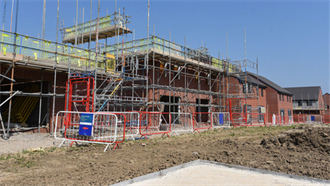With the real estate sector accounting for 40% of greenhouse gas (GHG) emissions globally, investors are increasingly demanding accountability and transparency on sustainability, causing leading actors to follow a path towards a low-carbon and responsible economy.
Notably, this request is not only coming from the market. Since May 2018, the Sustainable Finance Action plan of the European Commission (‘EU Action Plan’) has been guiding Real Estate actors to transition to more sustainable decision-making.
Consequently today, according to one of the biggest global Real Estate players, 60% of Real Estate investors have already adopted environmental, social and governance (ESG) criteria as part of their investment strategies.
Elements shifting the sector towards a more sustainable future
One pillar of the EU Action Plan is the EU Taxonomy Regulation. This classification system sets six environmental objectives and provides a set of common definitions that allows companies and investors to identify which economic activities contribute to these objectives.
Another backbone of the EU Action Plan, specific to investors, is the Sustainable Finance Disclosure Regulation (SFDR). To provide transparency to investors, this regulation defines common ESG classifications for financial products:
- Article 6 products do not promote any sustainable characteristics
- Article 8 promote ESG characteristics
- Article 9 pursue a sustainable investment objective
As a recent and evolving regulation, SFDR still triggers questions on how it applies. Interpretations regarding, for instance, the threshold percentage of sustainable investments for products to be qualified as Article 8 still vary among market participants and regulators. It also leads to the emergence of new market practices to offer so-called “Article 8+” products, which go beyond the minimum requirement of “regular” Article 8 products.
As per various market practices, an Article 8+ product could be the one that has ESG characteristics and takes into consideration Principal Adverse Impacts, or has Taxonomy-aligned investments, or contains a percentage of sustainable investments as per SFDR definition, among other interpretations. The European Securities and Markets Authority (ESMA) recently clarified that “regular” Article 8 products shall be marketed in a strict way. Namely, the product should not be called “sustainable” or “impact” among other adjectives, while only Article 8+ and Article 9 products can.
Success tied to the ability to measure impact
To achieve transparency, an effective measure of the ESG impact is fundamental. This is also a prerequisite to fulfil new reporting requirements. “ESG Impact” in Real Estate can take many forms over the life cycle of an asset, from using more sustainable materials in construction to reducing energy consumption in-use, ensuring accessibility for users with disabilities or efficiently managing waste during demolition. Asset managers should accordingly choose specific sustainability indicators for their funds to accurately represent the impact performance of the underlying assets, while also allowing for appropriate monitoring and comparability over time. To provide trust and reinforce reliability of the ESG data, external assurance is considered as a strong mean to ensure quality of the information disclosed.
To catch new opportunities and limit potential negative impacts by adding value to investments, ESG valuation can also be integrated in the three stages of an asset’s financial life: pre-acquisition, holding and pre-sale period. Real Estate players can perform a high-level climate risk assessment as a standard due diligence process to fully understand the risk exposure of each asset (e.g., changing weather patterns that could lead to flooding, additional taxation, changes in building codes that could require more expensive materials). Over the holding period, annual surveys related to climate change impact can be collected to understand the current exposure, while in the pre-sale period, mitigation and adaptation initiatives that have been implemented can be evaluated and included in the pricing of the asset.
Sustainability labels and certifications are increasingly used to evaluate assets’ ESG performance and identify so-called “green buildings”. Buildings constructed with more durable, low-maintenance materials may have longer economic lives, and green design features not only contribute to the path towards a low-carbon economy but may also reduce operating costs and increase net operating income.
GRESB, the Global Real Estate Sustainability Benchmark, also illustrates the most common practices among Real Estate players. Among other examples, having the fund’s ESG performance certified, designing a materiality assessment to identify material sustainability topics, or developing a well-thought out ESG strategy that conveys clear ambitions to stakeholders are among the most popular.
Trends in real estate impact investing
For many years the “E” of ESG has dominated attention in Real Estate. Fund managers are also now committing to other factors which focus on the “S” (social). In the face of intensified population growth, housing shortages and the rising cost of consumer goods, there is a growing need in cities to offer more affordable and better-quality housing.
This phenomenon also addressed population changes post-pandemic, with greater emphasis placed on remote work and the need for space. As a knock-on effect, municipalities of several cities are now taking efforts to facilitate lower-cost housing.
However, in many instances, the housing demand is higher than the current offer. Forward funding offers a solution to this by providing investors an opportunity to construct buildings tailored exactly to the needs of the market. Investors are then able to have a say in how a building is constructed (the quality and sustainability of materials used, the energy efficiency levels, the size, location, etc.).
Distinct from classic alternative funds, which typically hold and earn rentals from an asset for six to eight years and then refurbish and sell, the investment term for social impact Real Estate is typically longer with leasing periods spanning an extended time horizon, to align with the impact strategy of the fund and ensure its impact is positive in the long run. Understandably, these investment types are often more suitable to open-ended vehicles, which are not limited by lock-in periods or maturities.
Examples of market best practice
Based on our extensive experience working with Real Estate ESG funds, we see concrete best market practices examples that integrate ESG effectively at entity and product level. A dedicated ESG team in charge of monitoring funds’ performance, a corporate social responsibility policy, a 2030 sustainability strategy, and periodic sustainability reports are illustrations of how one real estate actor operates ESG on a daily basis.
This group also considers Sustainable Development Goals and further discloses information in line with the Task Force on Climate-related Financial Disclosures, examining physical and transition risks through a scenario-based climate risk assessment.
Another example of advanced ESG approach is how a Real Estate player considers Principle Adverse Impacts of its investment decisions on sustainability factors. It evaluates such impacts by reporting data on selected KPIs, from “GHG emissions” to “activities negatively affecting biodiversity-sensitive areas”.
The presence of green building certifications, solar panel installations or the percentage of new sites being a brownfield development are also considered.
These efforts are accompanied by challenges. The integration of ESG in the valuation process lacks normative frameworks and clear definitions of the environmental and social drivers affecting valuation can interfere with the process.
One of the current solutions would be to follow the widely recognised sustainability frameworks for real estate such as GRESB benchmark, INREV, SASB, TCFD, UN PRI that help report meaningful data in a structured way and showcase vehicles’ ESG efforts as well as steps for its future improvements.
The importance of ESG data is highly increasing. Given the diversity of rating organizations criteria as well as the absence of a common formula that clearly defines the value added brought by certifications to the funds and assets – make comparability difficult.
At EY we are leveraging on the analysis of more than 100 data providers to share with our clients a detailed ESG data landscape overview and help them make a right choice based on their strategy and needs.
Impact investing has a lot of potential in real estate but requires an effective ESG strategy in place that goes beyond the regulatory compliance and “checking off a list”. The key is to decide what is material and how the impact is created to determine appropriate metrics and goals.

































